
2.97 ct. Ceylon Sapphire
In the final installment of our series on how to evaluate the color of blue sapphires, we examine various ways to choose color, including personal preference, grading, science, and market price. The most controversial issue is whether or not the sapphire has been heat treated. We briefly review the history of heat treatments of sapphire and ruby, with special emphasis on the highly successful heat treatment of Geuda sapphire and its impact on the gem trade. Also mentioned are surface diffusion, beryllium diffusion, and glass filling. We end with a discussion of how treatments effect the price of sapphire.
Saturday, September 26, 2009
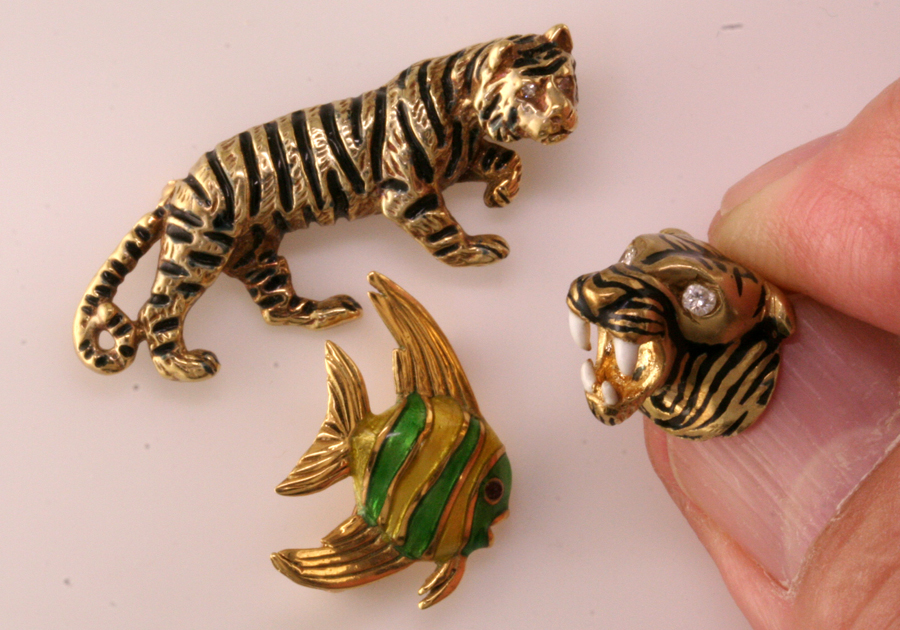
Recently, we had a real treat in purchasing a large group of estate jewelry items- many pieces were enameled, of European make. The enamels shown above feature the technique commonly referred to as “French” enameling, where the enamel is fired directly onto the face of the item as a final decorative touch. Even the fangs of the tiger’s head are skillfully enameled- Don’t you love it!
The real treasure of the group was this stunning Viking ship brooch of 18k gold and platinum, shown face on, skipping across the sea, sails and flag full of the wind. The brooch is boldly designed, perfectly executed, and the plique-a-jour sail is still in wonderful condition. Believe it or not- Italian make!

More about this collection at the Mardon blog.
Saturday, September 19, 2009

Gold in Quartz Watch Chain
In the latest Mardon blog, we discuss the California Gold Rush of 1849 and the jewelry it gave rise to. Forty-Niner goldsmiths and jewelers settled in San Francisco and created the classic gold in quartz styles. The best examples of vintage gold in quartz jewelry were made beginning 1850 and ending 1906, when the great earthquake put the hammer to the local jewelry making industry.
Current production of gold in quartz is focused in the Grass Valley area of California, with modest contributions from Australia and Alaska.
Wednesday, September 16, 2009

2.33 ct Ceylon Padparadscha, natural color, no heat
We beat the drum again for one of our favorites, the Padparadscha Sapphire. New pricing info and enlarged photos showcase our article on the gorgeous orangy-pink gem– or is it pinkish orange? We discuss the definition of Padparadscha color, countries of origin, Pad look-a-likes and imitations at the Mardon blog.
Thursday, September 10, 2009
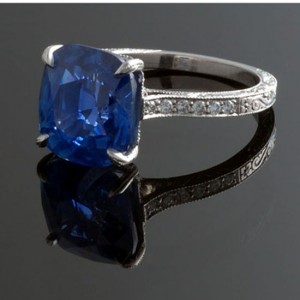
Superb 5+ ct. Kashmir Sapphire
This third part in the series explores the relationship between country of origin and the color of blue sapphires. We focus on the “classic” sources for the best blue sapphires, including Kashmir, Burma, Ceylon, and the new kid on the block, Madagascar, discussing quality of color, heat treatment, and values plus information about the geology and mining techniques. Visit the Mardon blog
Filed in Gemstones
|
Tagged alluvial deposits, artisanal mining, Burma, Ceylon, county of origin certificate, GIA, GRS, heat treatment, Kashmir, Madagascar, Mogok, Sri Lanka
|
Thursday, September 3, 2009

Magnificent 7.50 ct. Ceylon Sapphire in Custom Ring
Don’t miss this 4 part series on the blue sapphire. We’ll discuss gem grading and market preferences for blue sapphire, the physical characteristics of natural sapphires that affect their color, some of the characteristics of stones from classic sources of sapphire including Ceylon, Burma, Kashmir, Madagascar, Thailand, Australia, and Montana, and the various methods of color enhancement and heat treatment of sapphire. Only at the Mardon blog!
Filed in Gemstones
|
Tagged Australia, blue sapphire, Burma, Ceylon, color enhancement, gem grading, heat treatment, Kashmir, Madagascar, Montana, Thailand
|
Saturday, August 29, 2009
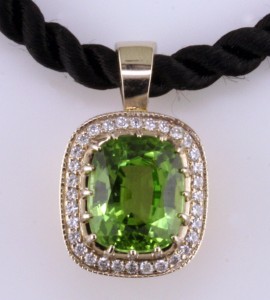
Custom Peridot & Diamond Pendant
One crucial skill in dealing with colored gemstones is to know the range of color each gem specie can display. I firmly believe many folks “don’t like peridot” because they’ve only seen commercial grade material or the more “chartreuse” rather brassy colors. Many jewelers sell the peridot short by only stocking lower grade material. I’ve proven to myself over and over that peridot can appeal even to those who believe they don’t like it. So if you like working with nice gems and don’t want to break the bank, try some of the best grades of peridot available to you– big color, big size, big pizzazz, moderate price–and they are never treated or enhanced in any way.
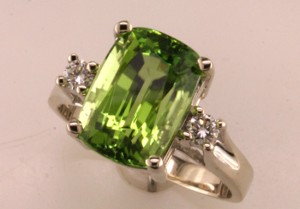
Wednesday, August 12, 2009
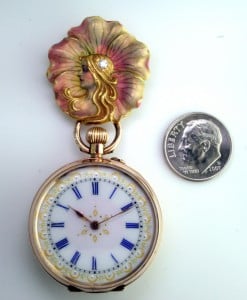
18K Enameled Art Nouveau Brooch, 9K Lady's Watch
This wonderful brooch/watch hanger with it’s portrait of a lady within a flower is quintessential Art Nouveau, expressing the romantic link with nature in a dreamy yet realistic style. The enamel has survived one century in perfect condition, probably due to it’s heavy construction. The enameling technique is superb, of subtle pink and flesh tones of opalescent enamel with matte finish, without bubbles, and beautifully accented with painted enamel “makeup” on the face and veining on the flower petals. See more pictures on the Mardon blog.

7.56 ct. Burma Peridot
The jeweler who hears a statement like this should take up the challenge— be prepared to show a beautiful peridot like this one. People who haven’t seen a good peridot will appreciate the experience. It’s a gem you can stock in top quality and good size for not a lot of money. Great stones are available from China, Pakistan, and Burma. For the “Buy American” customer, try the peridots from the San Carlos reservation, Arizona. And it’s never treated or enhanced, so peridot will appeal to many who are turned off by treated or enhanced gems. The combination of bright color, great clarity and sparkle, good wearability, and reasonable cost are hard to beat–if you can’t sell a good peridot, maybe you should consider another career!
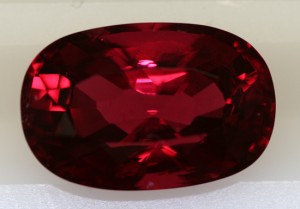
Wonderful 5.55 ct. Vietnamese Spinel
One of the hottest gems on the market in recent years has been the natural spinel. New finds in Tanzania and Vietnam have stimulated excitement in the gem trade for this sleeper gem. Long thought to be a type of ruby, the spinel in not well known to the public. In truth, this hot coal of a gem really offers many benefits for both the jeweler and his clients. It’s a fun and exciting gem to work with, and it’s a wearable and wonderful value for the new owner. Rarely heat treated, the spinel is one of the few pure red gems you can sell as completely natural. Visit our website for the first of several blogs on the spinel.











